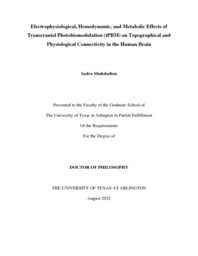| dc.description.abstract | Transcranial photobiomodulation (tPBM) targets the human brain with near-infrared (NIR) light and is shown to affect human cognitive performance and neural electrophysiological activity as well as concentration changes of oxidized cytochrome-c-oxidase ([CCO]) and hemoglobin oxygenation ([HbO]) in human brain.
Brain topographical connectivity, which shows the communication between regions of the brain, and its alteration can be assessed to quantify the effects of external stimuli, diseases, and cognitive decline, in resting-state or task-based measurements. Furthermore, understanding the interactions between different physiological representations of neural activity, namely electrophysiological, hemodynamic, and metabolic signals in the human brain, has been an important topic among researchers in recent decades. In my doctoral study, neurophysiological networks were constructed using frequency-domain analyses on oscillations of electroencephalogram (EEG), [CCO], and [HbO] time series that were acquired by a portable EEG and 2-channel broadband near-infrared spectroscopy (2-bbNIRS).
Specifically, my dissertation included three aims. The first one was to examine how tPBM altered the topographical connectivity in the electrophysiological oscillations of the resting human brain. As the first step, I defined and found key regions and clusters in the EEG sensor space that were affected the most by tPBM during and after the stimulation using both cluster-based power analysis and graph-based connectivity analysis. The results showed that the right prefrontal 1064-nm tPBM modulates several global and regional electrophysiological networks by shifting the information path towards frontal regions, especially in the beta band. For the second aim, I performed 2-bbNIRS measurements from 26 healthy humans and developed a methodology that enabled quantification of the infra-slow oscillation (ISO) power and connectivity between bilateral frontal regions of the human brain in resting state and in response to frontal tPBM stimulation at different sites and laser wavelengths. As the result, several stable and consistent features were extracted in the resting state of 26 young healthy adults. Moreover, these features were used to reveal some effects of tPBM on prefrontal metabolism and hemodynamics, while illustrating the similarities and differences between different stimulation conditions. Finally, the third aim was to investigate the resting-state prefrontal physiological network and the corresponding modulation in response to left frontal 800-nm tPBM by determining the effective connectivity/coupling between each pair of the electrophysiological, hemodynamic, and metabolic ISO of the human brain. Complementary to the previous studies, my study showed that prefrontal tPBM not only modulates the information path between two locations of the prefrontal cortex, it can also induce unilateral alterations in interactions between neural activity, hemodynamics, and metabolism. Overall, my dissertation shed light on the mechanism of action of prefrontal tPBM. | |


